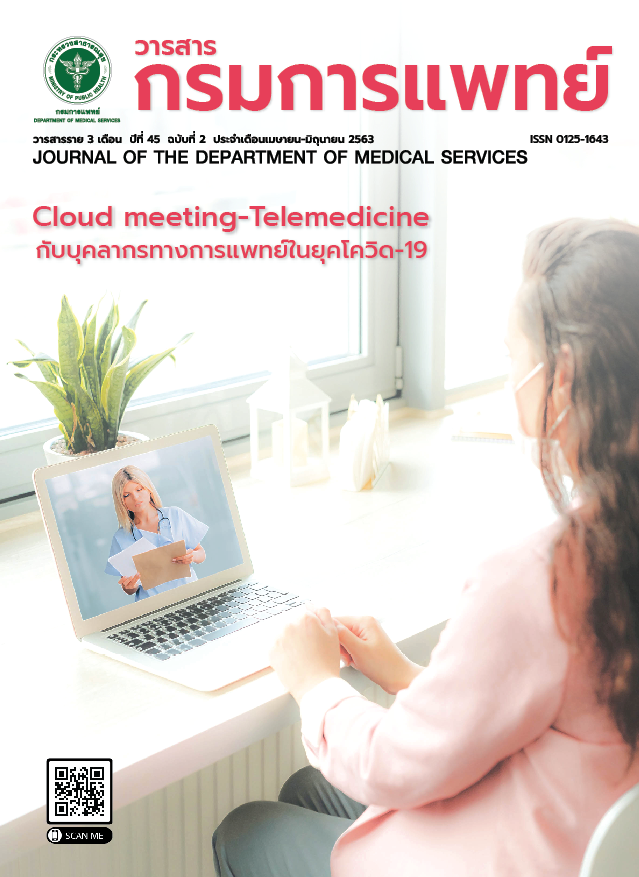ความรู้และทัศนคติของผู้เข้าร่วมกิจกรรมการป้องกันอุบัติเหตุในเด็ก ปฐมวัย
คำสำคัญ:
การป้องกันอุบัติเหตุในเด็กปฐมวัย, ความรู้, ทัศนคติบทคัดย่อ
ภูมิหลัง: การให้ความรู้เรื่องการป้องกันการบาดเจ็บจากอุบัติเหตุในเด็ก เป็นแนวทางการป้องกันอุบัติเหตุในเด็กเล็กที่มีประสิทธิภาพ ประเทศไทยมีการจัดกิจกรรมให้ความรู้เพื่อป้องกันการบาดเจ็บจากอุบัติเหตุเพิ่มขึ้น แต่การศึกษาถึงผลลัพธ์ของกิจกรรม เช่น ความรู้ ทัศนคติ ของผู้เข้าร่วมกิจกรรมในการป้องกัน อุบัติเหตุในเด็กยังพบน้อย
วัตถุประสงค์: ประเมินความรู้และทัศนคติการป้องกันอุบัติเหตุในเด็กปฐมวัยของผู้เข้าร่วมกิจกรรมการเรียนรู้การป้องกันอุบัติเหตุ เปรียบเทียบก่อนและหลังร่วมกิจกรรม
วิธีการ: ศึกษาข้อมูลย้อนหลังจากการจัดกิจกรรมให้ความรู้ป้องกันอุบัติเหตุในเด็กปฐมวัยในจังหวัดชลบุรี เปรียบเทียบคะแนนความรู้และทัศนคติของผู้เข้าร่วมกิจกรรม ก่อนและหลังการร่วมกิจกรรม โดยใช้สถิติ Paired t- test วิเคราะห์เนื้อหาความคิดเห็น
ผล: กลุ่มตัวอย่างจานวน 51 คน อาชีพครู 21 คน (ร้อยละ 41.2) นิสิตแพทย์ชั้นปีสาม 18 คน (ร้อยละ 35.3) พี่เลี้ยงเด็ก 7 คน (ร้อยละ13.7) และอื่นๆ 5 คน (ร้อยละ 9.8) ร่วมกิจกรรมการให้ความรู้รายกลุ่ม บรรยายและฝึกปฏิบัติในฐานเรียนรู้ 3 ฐาน คือ อุบัติเหตุจมน้ำ อุบัติเหตุจราจร และอุบัติเหตุภายในบ้าน ก่อนเข้าร่วมกิจกรรม มีค่าเฉลี่ยคะแนนความรู้ ร้อยละ 57.1 ทัศนคติ ร้อยละ 73.1 หัวข้ออุบัติเหตุจมน้ำมีคะแนนเฉลี่ยความรู้และทัศนคติน้อยกว่าคะแนนเฉลี่ยรวม หลังร่วมกิจกรรมคะแนนเฉลี่ยความรู้และทัศนคติต่อการป้องกันอุบัติเหตุเพิ่มขึ้น เมื่อเทียบกับก่อนร่วมกิจกรรมอย่างมีนัยสำคัญทางสถิติทุกหัวข้อเรียนรู้ มีคะแนนเฉลี่ยเพิ่มขึ้นในหมวดความรู้ร้อยละ 31.2 (p<0.001) ทัศนคติร้อยละ 16.9 (p<0.001) ผู้ร่วมกิจกรรมส่วนใหญ่แสดงความเห็นว่าได้ความรู้ มีทัศนคติที่เป็นประโยชน์ต่อการป้องกันอุบัติเหตุในเด็กปฐมวัย
สรุป: ผู้เข้าร่วมกิจกรรมหลังผ่านกิจกรรมเรียนรู้การป้องกันอุบัติเหตุในเด็กปฐมวัยมีความรู้และทัศนคติที่เป็นประโยชน์ต่อการป้องกันอุบัติเหตุมากขึ้นโดยเฉพาะอย่างยิ่งในหัวข้ออุบัติเหตุจมน้ำ
เอกสารอ้างอิง
Plitponkarnpim A, Chinapa M. Trend of child injury and drowning in Thailand, and child safety promotion initiative. Southeast Asian J Trop Med Public Health 2014; 45: 50-2.
Plitponkarnpim A. Chapter 10 Guidelines for enhancing safety and preventing injury. In: Noipayak P, Piyasil W, Ningsanon W, Ungthavorn P. Guideline in child health supervision. 1st ed. Bangkok: Sapphasan; 2014. p 101-26.
Watson MC, Errington G. Preventing unintentional injuries in children: successful approaches. Paediatr Child Health. 2016; 26: 94-9.
Patel D, Magnusen E, Sandell JM. Prevention of unintentional injury in children. Paediatrics and Child Health 2017 ; 27: 420-6.
Denny SA, Quan L, Gilchrist J, McCallin T, Shenoi R, Yusuf S, et al. Prevention of Drowning. Pediatrics 2019 ; 143: e20190850.
Sutchritpongsa S, Sangwisit S, Sonjaipanich S. Parental awareness of household injury prevention: adequacy of anticipatory guidance for well childcare. J Med Assoc Thai 2013; 96: 1531-5.
Aomsin K, Yingrengreung S. A Systematic Review: Home Injury Prevention Program for Children Aged 0–5 Years. Journal of Nursing and Health Care 2018; 36: 83-90.
Santagati G, Vezzosi L, Angelillo IF. Unintentional injuries in children up to six years of age and related parental knowledge, attitudes, and behaviors in Italy. J Pediatr. 2016 ; 177 : 267-72.
Nouman Y, Hussain M, Afzal M, Gilani SA. Effectiveness of health education among mothers to reduce unintentional home injuries of under-five year old children in rural community. Pak J of Public Health 2019; 9: 26-9.
Liu X, Yang J, Chen X, Li L. Knowledge, attitudes and behaviors on child passenger safety among expectant mothers and parents of newborns: A qualitative and quantitative approach. PloS one 2016; 11: e0146121.
Ingram JC, Deave T, Towner E, Errington G, Kay B, Kendrick D. Identifying facilitators and barriers for home injury prevention interventions for pre-school children: a systematic review of the quantitative literature. Health education research 2011; 27: 258-68.
Ngamsuoy A. Parental behavior enhancement toward childhood home accidental injury prevention. Nursing Journal 2018; 45: 253-60.
Suwantip N, Witthayawirasak B. Using participatory action research for injury prevention in child development centers, Suratthani province. Kasetsart Journal-Social Sciences. 2018; 39: 98-104.
Mytton J, Ingram J, Manns S, Stevens T, Mulvaney C, Blair P, et al. The feasibility of using a parenting programme for the prevention of unintentional home injuries in the under-fives: a cluster randomised controlled trial. Health Technol Assess 2014; 18: 1-184.
Chaudhary SS, Pan A, Pomerantz W, Miller B, Agarwal M.Pediatric Injury Prevention Programs Today: Identifying Markers for Success and Sustainability. Pediatrics 2018; 141: 76.
ดาวน์โหลด
เผยแพร่แล้ว
รูปแบบการอ้างอิง
ฉบับ
ประเภทบทความ
สัญญาอนุญาต
บทความที่ได้รับการตีพิมพ์เป็นลิขสิทธิ์ของกรมการแพทย์ กระทรวงสาธารณสุข
ข้อความและข้อคิดเห็นต่างๆ เป็นของผู้เขียนบทความ ไม่ใช่ความเห็นของกองบรรณาธิการหรือของวารสารกรมการแพทย์



